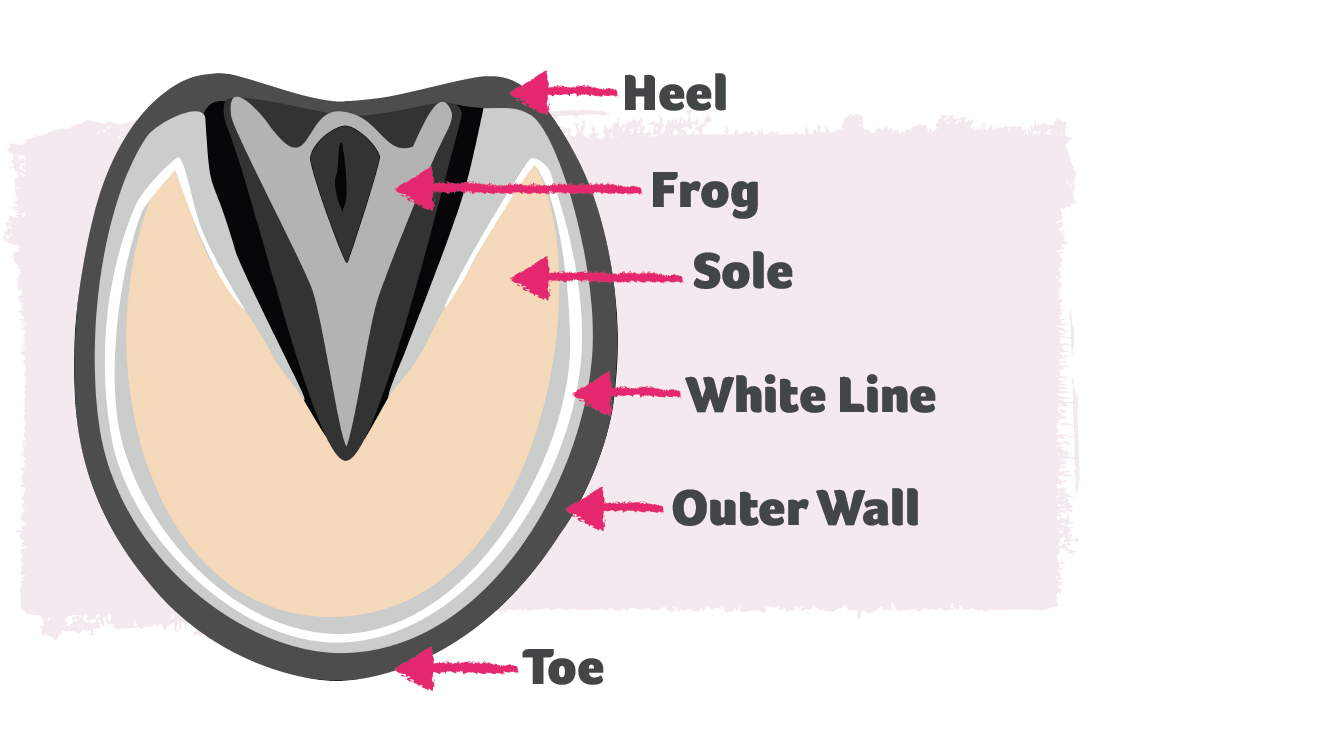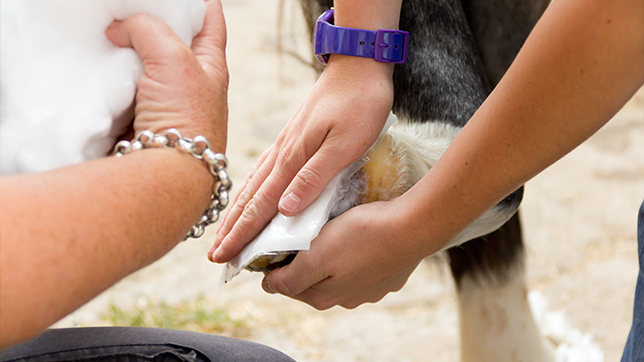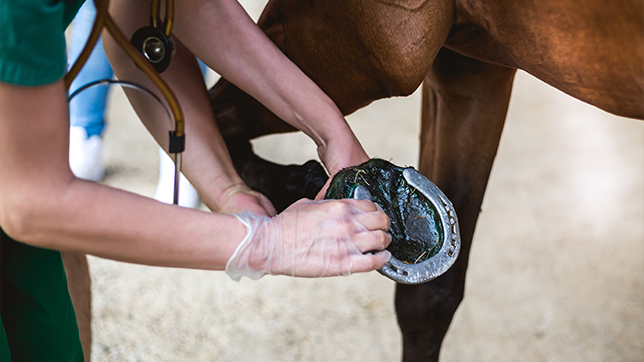22nd February 2024
Horse hoof abscess – symptoms, treatment, and poultices
An unfortunate part of horse ownership is having to deal with lameness.
Thanks to the combination of bad weather and muddy fields, hoof abscesses are a common cause of lameness in horses during relentless wet winters and showery spring months.
We’re going to explore the causes, symptoms, and treatment of the infamous hoof abscess, as well as sharing some top tips for hoof abscess prevention…
What is a hoof abscess?
A hoof abscess is created when there’s a build-up of pus (and therefore pressure) in your horse’s hoof, due to bacteria making its way through the hoof wall. Then, the place at which bacteria entered your horse’s hoof closes, trapping bacteria inside and enabling it to develop into an infection.
The inflammation and accumulation of pus in the sensitive part of your horse’s hoof will cause considerable pain. So, it’s vital that hoof abscesses are diagnosed and treated as quickly as possible.
Hoof abscess causes
One of the major causes of a hoof abscess can be a puncture wound (from something sharp, like a nail), which allows bacteria to enter the hoof beyond the white line.
Another significant cause of the hoof abscess is prolonged exposure to damp conditions, such as turnout on waterlogged fields. By spending a lot of time with their hooves immersed in wet, muddy conditions, your horse’s hoof wall will soften, letting grit get through even the tiniest of cracks.
Some of the other causes of hoof abscesses include:
- Incorrect hoof trimming.
- Incorrect shoeing.
- Badly fitted shoes.
- Weak soles (prone to bruising).
- Low heels.
- Turnout on rocky surfaces.
- Exercising on rocky surfaces (e.g. hacking).
- Moving from a wet field to a dry field, and vice versa.
- Stepping on debris (e.g. damaged fence posts).

Please note: Horses of any age, breed, hoof condition, or living situation (e.g. 24/7 turnout, mostly stabled, etc.) can have a hoof abscess at any time throughout the year!
Hoof abscess symptoms
Here are the primary symptoms of a hoof abscess in horses:
- Sudden, severe lameness – your horse may appear to be ‘hopping’ or refuse to put weight on their leg.
- Heat in their hoof – the infection causing your horse’s hoof abscess could create a lot of heat, as their immune system tries to tackle the problem.
- Noticeable digital pulse – a digital pulse can be located on the outside of your horse’s leg, directly above the fetlock at the point it meets the pastern. If you can feel a strong digital pulse, it’s an indication that there’s inflammation. (An equine vet should be able to show you how to check your horse’s digital pulse correctly!)
- Swelling of their lower leg – if you’re certain it’s a hoof abscess, but you notice swelling in your horse’s lower leg, please call the vet immediately (could be caused by an infection spreading).
Important: Signs of a hoof abscess might mimic the symptoms of different health concerns, including laminitis, tendon injuries, and a fractured pedal bone.
It’s essential to call your vet if you think your horse has a hoof abscess, to rule out other causes behind their lameness.
Hoof abscess treatment
After your vet has assessed your horse’s lameness, and overall health, they’ll likely use ‘hoof testers’ to apply pressure at various points around the hoof.
‘Hoof testers’ are a thin, pincer-like tool that enable a vet to test specific points of a hoof for pain using a controlled amount of pressure. If your horse reacts to use of the hoof testers, then your vet can feel confident they’ve found the site of a hoof abscess.
Provided they’ve been able to find the precise location of a hoof abscess, the vet might use a ‘hoof knife’ to create a small hole that allows pus to drain.
Alternatively, should your vet be unable to access the abscess, they may recommend using a wet poultice (see below!) for a few days, to draw pus out of the hoof.
Top tip: If you suspect a hoof abscess but your horse is shod, it’s helpful to ask a farrier to remove the shoe from their affected hoof before the vet arrives!
Most vets will recommend box rest until the hoof abscess has cleared completely, and they might prescribe painkillers or anti-inflammatory medication, to help your horse feel more comfortable.
In some cases, vets could decide to x-ray your horse’s lower leg if they’re uncertain as to exactly where the abscess has developed. X-rays will then provide your vet with an accurate image of the abscess, to help them determine the best course of treatment for your horse.
Thankfully, the majority of horses will start to feel better as soon as pus has drained (and pressure is released) from the hoof abscess – leading to a full recovery!
Applying a hoof poultice
The correct application of a hoof poultice may take a few attempts, especially if your horse is fidgety, so please don’t panic if it doesn’t happen first time!
Safety is vital when applying a hoof poultice.
Before you begin the process, it’s useful to arrange for a helper to be on hand to pass items to you, and take items from you, when needed.
We also recommend preparing the items you’ll need before applying the hoof poultice (e.g. cut the dressing to size and have sections of tape ready to use!).
Here are the items you’ll need to apply a hoof poultice:
- Tub of cooled, boiled water.
- Diluted, horse-friendly, antiseptic cleaning solution (e.g. Hibiscrub).
- Clean, dry towel.
- Self-adhesive, hard-wearing bandage material (e.g. Vetwrap).
- Poultice dressing (e.g. Animalintex).
- Cushioning layer (e.g. a nappy or non-fleecing cotton wool roll).
- Durable, waterproof, silver tape (e.g. duct tape).
- Protective poultice boot (optional!).
Please note: For a wet poultice, you’ll need to soak the poultice dressing in boiled water that’s been cooled before applying it to your horse’s hoof. Make sure you squeeze any excess liquid from the dressing before using it!

Your horse should be wearing a headcollar, with their lead rope safely attached to a tie ring via a quick-release knot. If your horse dislikes being tied up, ask someone to hold their lead rope and create a distraction using hay or feed.
Step 1: Clean the entirety of your horse’s hoof using a diluted, horse-safe, antiseptic cleaning solution. Then, dry their hoof thoroughly using a towel.
Step 2: Put the poultice dressing over the affected area (i.e. the section of hoof confirmed to be the abscess’ location), and press it down gently to keep it in place.
Top tip: A wet poultice works best for initially drawing pus out of the hoof abscess, then a dry poultice helps to protect the hoof once pus has started to drain!
Step 3: Wrap the cushioning layer over the poultice dressing and around sensitive parts of the hoof (e.g. their heel and coronet band; top of the hoof, just below the hairline).
Step 4: Carefully wrap the self-adhesive bandage around all areas of the hoof, to ensure that all parts of the poultice are held securely in place. This step could require multiple layers of bandage to be wrapped around the hoof.
It’s important to check the tension as you bandage your horse’s hoof, as well – since it shouldn’t be too tight or too loose. If in doubt, ask your vet to demonstrate how to bandage a hoof correctly.
Step 5: Cover the entire bandage in silver tape, to provide a tough, waterproof layer around the hoof poultice.
(Optional!) Step 6: Fit a poultice boot over their bandaged hoof, to lower the risk of the poultice being removed by your horse.
So, to recap the process for applying each layer:
Hoof > Poultice > Cushioning > Bandage > Tape > Poultice boot (optional!).
Remember: You’ll need to replace your horse’s hoof poultice daily, according to your vet’s instructions, until their hoof abscess has cleared.
Preventing hoof abscesses
There are several steps you can take to prevent your horse from getting a hoof abscess:
- Book regular appointments with a qualified, registered farrier.
- Always sweep the yard immediately after shoeing appointments, to limit the risk of horses stepping on discarded nails.
- Ensure their stable is cleared of soiled, wet bedding every day.
- Take care of your horse’s hoof health, according to vet and farrier advice.
- If they have brittle or sensitive hooves, give your horse a vet-approved hoof supplement in their daily feed (e.g. biotin).
- Provide a dry space for your horse to stand on if their field is muddy (e.g. a clean, dry field shelter).
- Rotate fields, to prevent them from becoming waterlogged and muddy.
- Check field fencing every day, clear any debris from their field, and repair broken fencing straight away.
- Remove any sharp stones and rocks from their field.
- Try not to exercise your horse on stony surfaces.

Don’t forget to check out our first aid tips for horse owners, to discover what to do if your horse needs emergency treatment while waiting for a vet.
We're fighting for a better future
For over 20 years we have remained committed to promoting animal welfare and conservation around the world.
Looking for more horse advice?
Support and advice so that owners and riders can take the very best care of their equine.
